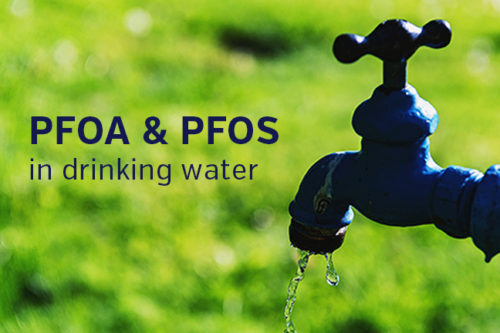OEHHA Issues Highly Anticipated Draft Public Health Goals for PFOA and PFOS in Drinking Water
July 30, 2021
Environmental law
Last week, the Office of Environmental Health Hazard Assessment (OEHHA) released draft public health goals (PHGs) for perfluorooctanoic acid (PFOA) and perfluorooctane sulfonic acid (PFOS) in drinking water. OEHHA’s announcement is several years in the making and is relevant for water purveyors and municipalities providing other related services such as wastewater treatment because PHGs are used to create enforceable drinking water standards and remediation goals for groundwater contamination. OEHHA’s development of PHGs is also relevant for assessing risk values under California’s Proposition 65. The public comment period on OEHHA’s draft PHGs begins July 30, 2021 and ends September 28, 2021.
PFOA and PFOS belong to a broad class of chemicals known as per- and polyfluoroalkyl substances (PFAS), which are highly fluorinated manmade compounds. PFAS are resistant to heat, water and oil. They are used in fire suppression foams and have been used in a wide range of products designed to be waterproof, stain‑resistant or non‑stick, such as carpets, furniture, cookware, clothing, and food packaging. PFAS are also highly ubiquitous, have been found in drinking water supplies, and are reported to have a variety of adverse health effects.
As we previously reported, in August 2019, the California State Water Resources Control Board (State Water Board) formally requested OEHHA to develop PHGs for PFOS and PFOA. A PHG is the level of a chemical contaminant in drinking water that does not pose a significant risk to health. Although PHGs are not regulatory standards, development of a PHG is an important step in the process to establish a maximum contaminant level (MCL), a regulatory standard for drinking water that a public water system must comply with and can be used as a groundwater remediation goal for contamination. The State Water Board must set drinking water standards as close to the applicable PHG as is economically and technologically feasible.
OEHHA’s underlying technical support document proposes PHGs for PFOA and PFOS at significantly low thresholds. More specifically, OEHHA proposes a PHG for PFOA at 0.007 parts per trillion (ppt) (based on kidney cancer in humans) and PFOS at 1 ppt (based on liver and pancreatic tumors in laboratory animals). According to OEHHA, the proposed PHGs are set at a level of risk of one additional cancer case per one million persons exposed over a lifetime. For comparison, the State Water Board’s current drinking water notification level for PFOA is 5.1 ppt and PFOS is 6.5 ppt. Public water systems are encouraged, though usually not required to test their water for contaminants that have notification levels, and if they test, public water systems are required to report exceedances to the State Water Board. Furthermore, the State Water Board’s current single health advisory response level for PFOA is 10 ppt and PFOS is 40 ppt based on a running four quarter average. Where detected levels exceed the response level, public water systems are required to take the water source out of use or provide public notification within 30 days of the confirmed detection. Accordingly, OEHHA’s draft PHGs for PFOA and PFOS are significantly lower than the thresholds used for current drinking water notification and response levels.
OEHHA’s development of PHGs is also relevant under the Safe Drinking Water and Toxic Enforcement Act of 1986 or “Prop. 65.” Prop. 65 prohibits businesses from releasing chemicals “known to the state to cause cancer or reproductive toxicity” into drinking water sources, and from exposing people to chemicals on the Prop. 65 List without providing “clear and reasonable” warnings. Both PFOA and PFOS are on the Prop. 65 List as causing developmental or reproductive toxicity. Further, OEHHA is considering whether to list PFOA as a carcinogen. OEHHA’s development of PHGs is noteworthy because the final PHGs can be used in risk assessments for purposes of complying with Prop. 65.
In addition to the above-listed regulatory compliance issues, OEHHA’s development of PHGs is relevant for remediation goals and related litigation more generally. MCLs are frequently used in regulatory enforcement and litigation matters as a “benchmark” for cleanup standards. In addition, the establishment of an MCL is typically viewed as a main event to trigger statutes of limitation to seek relief and damages for certain cleanup actions.
Finally, OEHHA’s release of PHGs for PFOA and PFOS must also be considered within the framework of similar developments at the federal level. On July 19, 2021, the U.S. Environmental Protection Agency (USEPA) released its latest list of water contaminants to be potentially regulated under the Safe Drinking Water Act (SDWA). This action is a first step that can lead to USEPA’s actual regulation of chemicals under the SDWA. Although PFOA and PFOS are not specifically listed and PFAS are listed more generally, many expect USEPA to continue targeting PFOA and PFOS for inclusion in federal drinking water standards.
As noted above, interested members of the public can submit public comments on OEHHA’s draft PHGs. The public comment period begins July 30, 2021 and ends September 28, 2021. In addition, OEHHA is holding a virtual public workshop on September 28, 2021, from 1:00 p.m. to 4:00 p.m. Pacific Time. For additional information, please click here.

